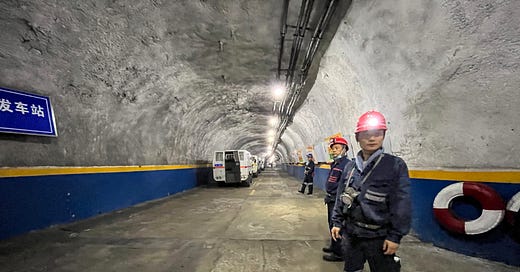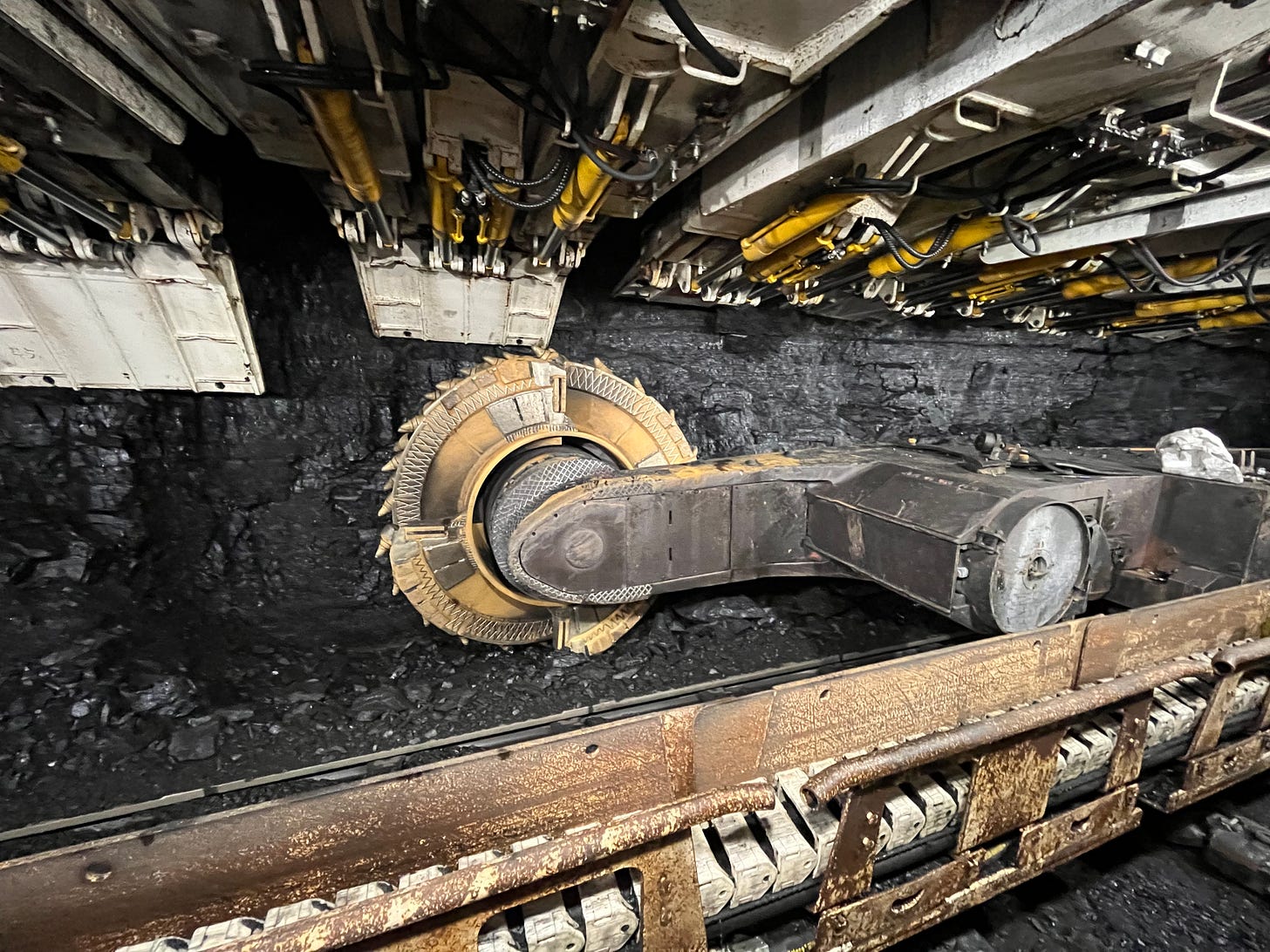Journey to the Center of the Earth: Discovering China’s smart coal mines
The policy and financial incentives for Chinese coal mines to embrace smart technology
Recently I had a rare chance to visit a few coal mines to learn about their drives to become smarter with AI technology. The mines I visited are located in Ji’ning and Heze cities in the Eastern province of Shandong and are all state-owned.
Most of the convos are recorded in this thread on background so they won’t be attributed to any particular person.
A few foreign media were given access to similar smart mines in Shaanxi earlier, and they offered good explainers on how the mines are becoming smarter, but instead of the tech aspect, I got to ask more policy questions that are prompting the mines to embrace smart tech.
Big screen monitor of operations
First, an overview of China’s coal mining industry.
According to the national bureau of Statistics, China’s coal production and consumption steadily grew in the 2000s and plateaued after 2013. In 2021, China produced 4.13 bln tons of coal. There’s a consistent gap between production and consumption numbers, but the shortage has been shrinking.
According to a 2015 tally, state-owned and private-owned coal mines each make up roughly half of the number of mines, but SOEs contribute to 80% of the output.
During the visit one engineer gave me a simple and clear description: China has both mines with world-class working environments and those with awful conditions. I’m pretty sure he hasn’t visited all coal mines in the world, but I think the message is clear: there’s a huge disparity in mining conditions throughout China.
400 meters below ground
Needless to say, the ones we visited were state-owned and probably among the ones with better working environments.
So why the push to employ smart technology?
First, the mines are feeling a shortage of laborers. Though income for miners exceeds the local average by many times, such income cannot attract enough qualified workers, as the working conditions are considered too harsh.
“We want educated young workers with professional skills, but our pay isn’t competitive enough,” one person explained to me, “even for lesser educated young people who came out of vocational schools, they are turned away by the hard labor.”
“But even if you become a deliveryman, that’s still hard work, right?” I asked.
“Above ground, you are at least connected to the internet,” the person answered.
Lacking young workers has created an aging problem for the mines’ workforce, as a significant chunk of their workforce faces retirement soon, and going smart is considered an inevitable way to mitigate the effect.
Miners now operate a dozen meters away from the tip of the drill, boosting safety.
Then there’s the nudge from the government, which has two folds.
First, government policies incentivize smart technologies. Chinese coal mines, especially the state-owned ones, are given quotas on how much they could produce, which is much lower than the mine’s full capacity, therefore capping the revenues. But the government would rank the mines in terms of automation and award mines with higher scores with extra quotas.
Furthermore, the government would support the more automated mines to secure low-interest debt, sweetening the deal for many mine executives.
Then there’s the safety angle. The Chinese government has significantly raised the importance of production safely in recent years, this means stricter safety inspections and stiffer punishments, such as longer shut-down periods if somebody gets injured or dies.
This further incentivized the mines to reduce the number of miners in exchange for machines.
“Sure we pay a lot for the systems, but if we get shut down for 6 months due to some injury or death, that’ll be an even bigger loss,” a mine executive said.
At a farewell banquet toward the end of the tour, I sprang a question on a coal mine executive sitting next to me, “What keeps you up at night, as the boss of a mine that employs more than 2000 people?”
He was surprisingly blunt and didn’t hesitate to choose his words.
“Safety. I’m terrified something happening in the mines.”
Geo-hazard also compels some of the mines to use smart tech. The mine we visited in Heze said their mine suffers from high geothermal heat and pressure, and applying more automation helps offset some of the risks.
Tech-intensive machinery that has transformed how coal is produced
Smart technology is as good an answer as any for these headaches. It not only reduces the workers needed down the shaft but lightens the workload, shortens their shifts, and creates a better working environment, which appeals to would-be workers.
Smart technology cut the number of first-line miners by as much as 50%, I’m told, while it means stuffing more miners into non-production positions temporarily, it will ultimately help the mines with a smooth transition.
Cutting first-line workers may also have a gender implication. As more workstations rise to above ground and don’t need as much manual labor, technically this opens the door to more female employees. People I asked admitted as such, but it’s unclear how soon the change will come, as the mines have a very male dominant culture.
Will smarter mines mean layoffs? The executives I spoke with said as SOEs, they must consider social responsibilities and not lay off any workers whose work had been replaced by AI-empowered machines. They are transferred to more supporting roles until retirement.
Do smart systems help the mines turn up their profit? None of the people I asked told me straight up that it did, and the fact that it’s mostly state-owned mines that are testing out smart techs say it’s not an investment so readily embraced by everybody. But the people I asked say everything considered, going smart is the right way to go.
First, as explained above, they help improve the working environment and reduce safety hazards, which help the mines keep workers happy and attract prospective workers. While the reduced human cost and improved efficiency do not necessarily make up for the cost of the systems, the mines could save on compensation for work-related injury/death and benefit from avoiding shutdowns. Furthermore, the increased production quotas and low-interest loans could also contribute to the mines’ cash flow.
Secondly, the executives I talked to say that smart technology represents the future, and it’s not a question of whether but when to start going smart.
“We hope that going smart would help us stay competitive in the long run,” an executive said.
How did the mines and miners adapt to the newer systems?
Everyone, including executives and first-line workers, painted a similar picture. The miners disliked the smart systems because it meant learning new skills and ditching familiar ways of doing things. But now after the miners got used to using the new systems, they can’t live without it.
“It’s like when starting to use a smartphone, at first it’s awkward, but after a while it’s indispensable.”
Mr. Liu, a middle-aged miner, told me he’s a third-generation miner, and his working environment today is drastically different than that of his granddad and dad.
Mr. Liu (right) says if his father, in his 80s, were to visit the mines today, he wouldn’t recognize it.
“Back in the day they did everything manually, blasting through the rocks with dynamite and securing the alleys with beams, they worked bare top and were black all over. It was considered an extremely dangerous and hard job. But now that we are using smart technology, I wouldn’t worry too much if my son decided to become a miner.”
We were shown a space where miners practiced with a mock machine and test-drove machinery. We were told that tests were organized for these miners, and those who came behind will be penalized.
Miners prepping for operation tests
The last thing I want to mention is that tech companies such as Huawei benefit too from the cooperation. They work closely with the mines to collect their feedback and improve their algorithm or hardware, in the hope that their product can be put to use in more complicated settings and become more user-friendly.
I was told that Huawei and the mines we visited will launch in July a first-ever AI model for mines, which they described as “the ChatGPT of industrial application“.
All in all, though I know what I saw is not representative of all coal mines in China. In fact, on the exact day that I left Shandong, a coal mine in Shanxi province had a deadly incident that killed 3. But the smart techs that I saw pointed to a future that looked and felt promising.
A mine car named happiness










A very welcome kind of reportage.
There was only one detail, a two-letter word, that made my mind get tense: AI.
AI is a term that is more or less deceptive:
https://www.wired.com/story/how-we-learn-machine-learning-human-teachers/
Thirty years ago, AI meant machine intelligence fully developed to be human-like. like HAL 9000.
What we have now is simply some currently advanced software, popularly promoted and known as "AI".
Impressive, another advantage of reducing the number of frontline workers is reducing exposure to coal dust.